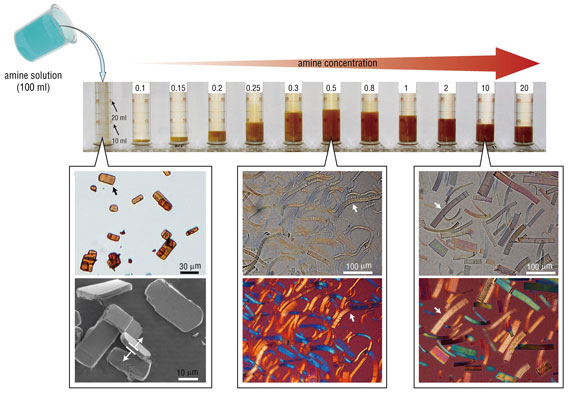| Mar 30, 2013 |
Inorganic materials display massive and instantaneous swelling and shrinkage
|
|
(Nanowerk News) Two-dimensional (2D) crystals have unique properties that may be useful for a range of applications. Consequently there is high interest in the mechanism for producing 2D crystals by exfoliating materials with layered structures. Now researchers in Japan have reported ("Unusually stable ~100-fold reversible and instantaneous swelling of inorganic layered materials") an unusual phenomenon that layered materials undergo drastic swelling without breaking into separate 2D crystal layers. “The findings demonstrate important implications for and chemical insight into the exfoliating process,” say the researchers.
|
|
Certain ions or solvents can infiltrate materials with layered structures. This ‘intercalation’ sometimes causes excessive swelling and ultimately exfoliation into separate layers. The process of exfoliation has been studied in a number of materials including graphite, oxides, and hydroxides among others. In all these materials, exfoliation into separate layers occurs after swelling of less than several nanometres, which raises difficulties in analysis of the swelling stage, and hence the exfoliation mechanism as a whole.
|
 |
| Macroscopic volume and microscopy characterization of the samples before and after swelling. The parent H0.8[Ti1.2Fe0.8]O4 H2O microcrystals exhibit platelets with lateral sizes of ~15 micrometer×35 micrometer and a thickness of ~2-3 micrometer. The interlayer spacing is 0.89 nm; thus, the platelets are composed of ~3000 regularly stacked layers. With addition of amine solutions, the samples “ballooned” spontaneously, and the macroscopic volume of the swollen crystals changes with various DMAE solutions, which shows the maximum volume increase at DMAE/H+ = 0.5. Optical microscopy characterizations reveal extended lamellar structures. The longest swollen length is ~200-250 micrometer in DMAE/H+ = 0.5. At high concentrations, the swelling is somewhat suppressed, with swollen length of ~100 micrometer at DMAE/H+ = 10.
|
|
Now Takayoshi Sasaki and colleagues at the International Center for Materials Nanoarchitectonics at the National Institute for Materials Science and the Fukuoka Institute of Technology in Japan have realized up to 100-fold swelling of layered protonic oxides, otherwise known as solid acids, without exfoliation, by exposure to an aqueous amine solution. Adding HCl reduced them to their original size. Notably, n the process more than3000 atomic sheets, which comprise of the starting crystal, instantly move apart and reassemble like shuffled poker cards.
|
|
Unlike previously reported swelling or exfoliation, which swell far less before exfoliation, the swollen structures produced by exposure to the amine solution remained stable even when shaken. The researchers explain the stability using molecular dynamics calculations. “Unlike the random H2O in the previously reported swollen phases that could be easily exfoliated, long-range structuring of the H2O molecules in the highly swollen structure was confirmed using first-principle calculations.” The observations also provide important insights into the physics of these systems.
|

